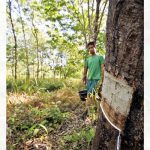Low production and quality to blame for rubber sector’s export woes

Low productivity, high labour costs and sub-par quality are holding Myanmar back from becoming a serious rubber producer, experts say. The nation’s rubber plantations produce at less than half the international production rate, and a rise in volume must be matched by improvements in product quality, says Hajime Kondo, manager of Bridgestone’s tyre materials advanced development department. But growers complain that at current world rubber prices, they don’t earn enough income to pay a labour force increasingly attracted to job opportunities elsewhere, both in Myanmar and overseas. “While other countries produce 1.5 tonnes of rubber per hectare, Myanmar produces 0.8 tonnes. And Myanmar is very different from other countries in terms of fixing rubber grading,” said Mr Kondo. A recent seminar in Yangon Region on the sustainable natural rubber initiative allowed industry professionals to share information about the natural rubber supply chain.

